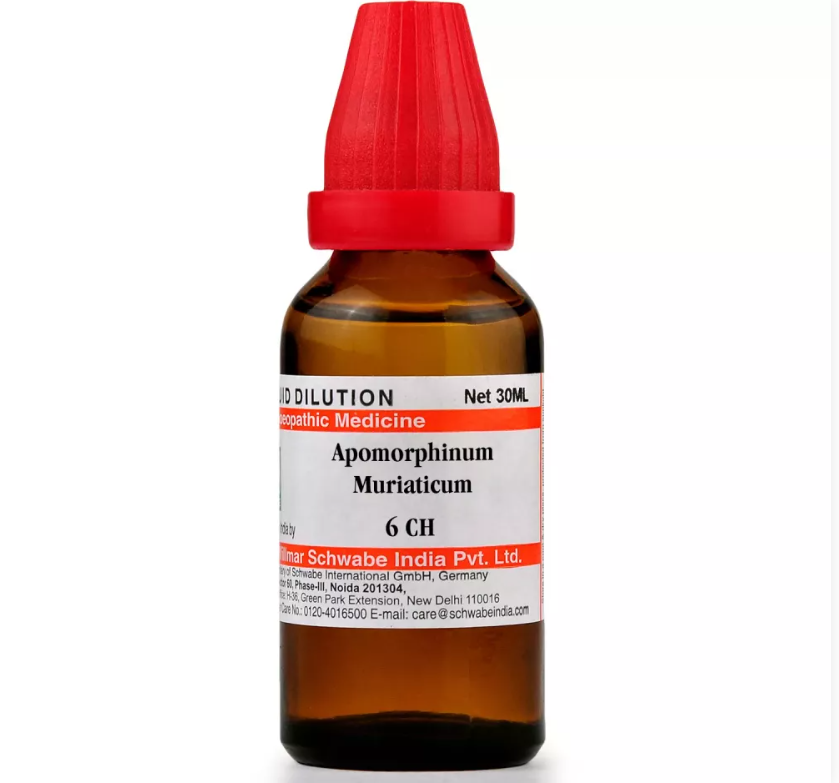APOMORPHINUM HYPOCHLORICUM 6C, 12C, 30C, 200C, 1M, 10M USES AND SYMPTOMS
 Apomorph.
Apomorph.
This drug’s primary strength lies in its prompt and efficient induction of vomiting, a distinctive trait guiding its homeopathic application. Vomiting follows a sequence of nausea, weariness, and heightened secretion of sweat, saliva, mucus, and tears. It’s effective for pneumonia accompanied by vomiting, alcoholism with persistent nausea, constipation, and insomnia.
Head: Dizziness. Enlarged pupils. Sensation of heat, particularly in the head.
Stomach: Dry heaves with headache; acid reflux; pain between shoulder blades. Pregnancy-induced vomiting. Motion sickness. Nausea and vomiting. Intense urge to vomit.
Non-homeopathic Uses: A hypodermic injection of one sixteenth of a grain triggers complete vomiting within five to fifteen minutes in adults, without other noticeable effects. Avoid in opium poisoning. Hypodermic use of Apom. in doses of one-thirtieth of a grain or less acts as a safe and reliable sedative, even in cases of delirium. Sleep ensues within thirty minutes.
Dosage: Third to sixth potency.
SYMPTOMS OF APOMORPHINUM HYPOCHLORICUM
Apomorphine.
Effective vomiting inducer
Preceded by nausea, fatigue, increased secretion
Useful for pneumonia with vomiting, alcoholism with nausea, constipation, insomnia
Head:
Dizziness
Dilated pupils
Heat sensation, especially in the head
Stomach:
Dry heaves, accompanied by headache
Heartburn
Pain between shoulder blades
Reflex vomiting in pregnancy
Motion sickness
Nausea and vomiting
Strong urge to vomit
Non-homeopathic Uses:
Hypodermic injection induces vomiting within 5-15 minutes
Avoid in opium poisoning
Hypnotic effect with doses of one-thirtieth of a grain or less
Effective sedative, even in delirium; induces sleep within 30 minutes
Dosage: Third to sixth potency.
selection of the potency
Individualization:
- Homeopathy is based on the principle of treating the individual, not just the disease. The unique symptoms and characteristics of the person are crucial in determining the most suitable potency.
Intensity of Symptoms:
- The intensity of the symptoms guides the choice of potency. If the symptoms are intense and acute, a lower potency (e.g., 6C, 30C) might be considered. For chronic conditions with less intensity, higher potencies (e.g., 200C, 1M) may be appropriate.
Sensitivity of the Patient:
- Some individuals are more sensitive to homeopathic remedies, while others may require higher potencies. The practitioner considers the patient’s sensitivity when selecting the potency.
Acute vs. Chronic Conditions:
- Lower potencies are often used for acute conditions, while higher potencies may be considered for chronic or long-standing issues.
Previous Response to Potencies:
- The patient’s response to previous homeopathic treatments helps guide the choice of potency. If a particular potency has been effective in the past, it may be repeated or adjusted as needed.
Vital Force and Susceptibility:
- Homeopathy views illness as a disturbance in the vital force. The practitioner assesses the patient’s overall vitality and susceptibility to determine the appropriate potency.
Aggravation or Amelioration:
- The direction of the symptom response (aggravation or amelioration) after taking a remedy can influence the choice of potency.
Miasmatic Considerations:
- In classical homeopathy, the concept of miasms (inherited disease tendencies) is considered. The practitioner take this into account when selecting the potency.
Practitioner Experience:
- The experience and preference of the homeopathic practitioner play a role. Some practitioners may have success with certain potencies based on their clinical experience.
SAFETY INFORMATION
- Do not exceed the recommended dose by physician
- Keep out of the reach of children
- Store in a cool dry place away from direct sunlight
- Maintain half an hour gap between food/drink/any other medicines and homoeopathic medicine
- Avoid any strong smell in the mouth while taking medicine e.g. camphor, garlic, onion, coffee, hing
Medicine images use for reference only selection of homeopathic medicine depends on the individual’s specific symptoms and overall constitution. Moreover, homeopathy is a holistic system of medicine that treats the individual as a whole. In addition to addressing the physical symptoms, it takes into account the emotional and mental state of the person. Consequently, it’s crucial to consult with a qualified homeopathic practitioner for personalized treatment.
The information provided on this website is intended solely for educational purposes. Always seek the advice of your physician or other qualified health provider.
